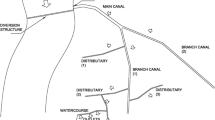Abstract
Tank irrigation is one of the oldestsources of irrigation in India. Decline inthe area irrigated over the years due toinadequate operation and maintenance,large-scale development of groundwatersources, disintegration of traditionalirrigation institutions, heavy siltation,encroachment, etc., has resulted in heavysupplemental well irrigation in order toavoid crop losses. Rice yield from farmswith supplemental well irrigation wasobserved to be high. Even though it ispossible to calculate the value ofgroundwater for different years, it isdifficult to obtain the value of thegroundwater used to stabilize riceproduction from tank irrigation. The modeldeveloped in this paper is used tocalculate the stabilization value ofgroundwater using the Srivilliputhur BigTank, which is a representative tank inTamilnadu, India.
A mathematical formula is used to model theeconomics of conjunctive surface andgroundwater irrigation systems. Analyticalexpressions for the value of groundwaterand the stabilization value of groundwaterare derived, assuming that the amount ofsurface water is a general stochasticvariable with a probability densityfunction, and that the demand function forirrigation water is also of that generalform. Finally, the model is applied toreal data collected during the period 1986to 2000 for the Srivilliputhur Big Tank inTamilnadu, India, and the value ofgroundwater and the stabilization value ofgroundwater are calculated at 1999–2000constant prices. The results indicatedthat the stabilization value of groundwater(covering the entire tank area of 402 ha.)was Rs. 166,677, while the value ofgroundwater was Rs. 1,064,720. Thus, about15.7% of the value of the groundwater wasused for its stabilization. Using thestabilization value of the groundwater infuture investment analysis will help tomore accurately indicate project benefitsdue to groundwater supplementation in thetank command areas.
Similar content being viewed by others
References
Hann C.T. 1977. Statistical Methods in Hydrology. The Iowa State University Press, Ames, Iowa.
Hildebrand F.B. 1977. Advanced Calculus for Applications. Prentice Hall of India Private Limited, New Delhi.
Palanisami K. & Easter K.W. 1991. Hydro-economic interaction between tank and well water. Indian Journal of Agricultural Economics 46(2): 174-179.
Palanisami K. & Flinn J.C. 1988. Evaluating the performance of tank irrigation systems. Agricultural Systems 28: 161-177.
Palanisami K., Balasubramanian R. & Mohamed Ali A. 1997. Present Status and Future Strategies of Tank Irrigation in TamilNadu. Bulletin/97, Water Technology Centre, Tamilnadu Agricultural University Press, Coimbatore.
Palanisami K & Easter K.W. 2000. Tank Irrigation in the 21st Century-What Next.Discovery Publishing House, New Delhi.
Tsur Y. 1997. The economics of conjunctive ground and surface water. In: Parker & Y. Tsur (Eds), Decentralization and Coordination of Water Resource Management. Kluwer Academic Publishers, London.
Author information
Authors and Affiliations
Rights and permissions
About this article
Cite this article
Ranganathan, C., Palanisami, K. Modeling Economics of Conjunctive Surface and Groundwater Irrigation Systems. Irrigation and Drainage Systems 18, 127–143 (2004). https://doi.org/10.1023/B:IRRI.0000040251.52864.7e
Issue Date:
DOI: https://doi.org/10.1023/B:IRRI.0000040251.52864.7e




